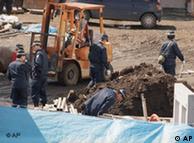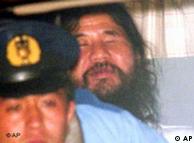Japan Captures Fugitive Linked to Tokyo Sarin Gas Attack
Voice of America
Acting on tip, police arrested Katsuya Takahashi, 54, Friday morning in a comic book cafe, concluding 17-year manhunt.
逃亡17年 東京地鐵毒氣案最後通緝犯落網
 |
| 日本東京地下鐵沙林毒氣案涉案嫌犯高橋克也,逃亡十七年後,十五日於東京落網。高橋容貌在逃亡多年後,已經有很大改變。 (法新社) |
現 年五十四歲的高橋克也,為奧姆真理教的幹部,涉嫌參與地下鐵沙林毒氣案等案件,被以涉嫌殺人及殺人未遂等罪嫌列為重大通緝犯,懸賞金高達一千萬圓(約三百 七十七萬台幣)。同案被通緝的另兩名嫌犯,包括奧姆真理教的前幹部平田信,已於去年十二月三十一日自首,涉嫌製造沙林毒氣的女性嫌犯菊地直子,也於本月三 日在神奈川縣落網。
日媒報導,菊地在三日被捕後,警方已同時掌握到高橋的行蹤,但生性機警的高橋早在警方上門之前,從金融機構領走了二百三 十多萬圓存款逃逸,警方調出監視器拍攝的畫面,更新通緝照片,並且發動五千多名警方在東京地區進行全面搜索,終於在十五日上午接獲報案,進而逮捕了逃亡十 七年的高橋。
網咖店員機警認出
警方表示,上午八點半(台灣時間七點半)左右,接獲大田區一家漫畫網咖店店員報案指出,店裡一名可疑男子很像高橋,警員九點多趕到漫畫店,詢問該名男子「是不是高橋」,男子回答「是」,隨後將他帶到警局,比對指紋後確認了身分。
招牌濃眉不再 警險錯失逮捕
不 過,日本電視台報導,警方在這波逮捕行動中差一點又凸槌,報案的漫畫網咖店店員在接受訪問時指出,警方到場看了一眼店員所指的「可疑男子」時,竟然還跟店 員說「雖然長得有點像,不過你認錯人了」。這時男子似乎發現警方到場急著結帳,員警為了保險起見上前盤查,男子竟然乾脆地承認自己就是高橋。
躲藏十七年的高橋克也容貌變化很大,招牌的濃眉也變得較稀疏,他多年來用假名四處工作,被捕前在川崎市一家建設公司上班,該公司人員說,高橋總是戴著口罩,還要求做不會跟人接觸的工作。
當年造成13死 6300人傷
東 京地下鐵沙林毒氣案發生於一九九五年三月二十日,東京三條主要地下鐵路線的五列列車遭人施放沙林毒氣,造成十三人死亡、約六千三百人受傷。奧姆真理教及相 關人士被指犯下該案及多起綁架、謀殺與郵包炸彈案,全案共有一百九十人被起訴,包括主謀的教主麻原彰晃在內十三人被判死刑、五人無期徒刑。
Terrorism | 19.03.2010
15 years since nerve gas attack on Tokyo subway
Previously, the number of people thought to have been injured in the Tokyo subway attack of 1995 was around 5,500 but recently Japan’s National Police Agency placed the number at over 6,000.
The attack was carried out by members of a cult called Aum Supreme Truth, who planted plastic bags containing sarin, a nerve gas, in five underground trains.
Inspired by Buddhism, Christianity and sci-fi Bildunterschrift: Großansicht des Bildes mit der Bildunterschrift: After the 1995 attack on the subway, police found gold bars, chemicals and millions of yen near an Aum compound
Bildunterschrift: Großansicht des Bildes mit der Bildunterschrift: After the 1995 attack on the subway, police found gold bars, chemicals and millions of yen near an Aum compound
 Bildunterschrift: Großansicht des Bildes mit der Bildunterschrift: After the 1995 attack on the subway, police found gold bars, chemicals and millions of yen near an Aum compound
Bildunterschrift: Großansicht des Bildes mit der Bildunterschrift: After the 1995 attack on the subway, police found gold bars, chemicals and millions of yen near an Aum compound
"The group was founded in the mid-1980s," explains Verena Blechinger-Talcott, an expert on Japanese politics at the Free University of Berlin. "It originally started out as a yoga class. The name Aum comes from a word in Buddhism, the Sanskrit syllable which represents the universe."
The cult was based on a combination of Buddhist and Christian teachings and also integrated science fiction. Blechinger says the group was inspired by a manga cartoon called "Starship Yamato" that was popular in the 1970s and 80s and told the story of aliens coming to earth.
Before the 1995 attack, the group worked on biological and chemical warfare techniques and recruited scientists. Experiments included planting substances in subways and spraying anthrax in the air.
Blechinger says the group also looked into cooperating with Russian nuclear labs. "The whole idea was that these were just preparations for some future attacks they wanted to perform. The idea of the group was to bring about the end of the world and cause the supreme forces that are somewhere out in the universe, those aliens, to come and save the world."
The group’s leader, who goes by the alias Shoko Asahara, had up to 10,000 followers at the cult's peak, many of whom lived in cult compounds.
Religion is important in Japanese society
Aum is banned in certain countries, including Russia, but not in Japan, which now has over 300 "new religions". Blechinger says religion and syncretism is very important in Japanese society.
"The group was not officially banned and is still active. They changed their name in 2000 because of the attacks, and are now called ‘Aleph’, which is the first letter in the Hebrew alphabet. Again it means the first, the universal letter and they still have about 1,600 members."
The Japanese constitution protects religious practice. But after the attacks, a few small changes were introduced.
"It is still a touchy subject," says Blechinger. "There is the distrust in new religious cults, but overall, Japan is a very tolerant society, especially toward religious groups. It is considered a private thing, so as long as there are no signs that indeed there is a danger for society, there wouldn’t be public investigations into cults."
 Bildunterschrift: Großansicht des Bildes mit der Bildunterschrift: Shoko Asahara, the leader of the Aum Shinri Kyo cult, is on death rowAsahara, the cult’s leader, and 12 other high-ranking members are now on death row for an array of charges. 10 have exhausted their appeals. Several Aum members are still on the run.
Bildunterschrift: Großansicht des Bildes mit der Bildunterschrift: Shoko Asahara, the leader of the Aum Shinri Kyo cult, is on death rowAsahara, the cult’s leader, and 12 other high-ranking members are now on death row for an array of charges. 10 have exhausted their appeals. Several Aum members are still on the run.
Blechinger points out although there is an increasingly "strong anti-death penalty movement, the public is largely for the death penalty", especially when people such as Asahara are awaiting execution.
Author: Sarah Berning
Editor: Anne Thomas
Editor: Anne Thomas

沒有留言:
張貼留言